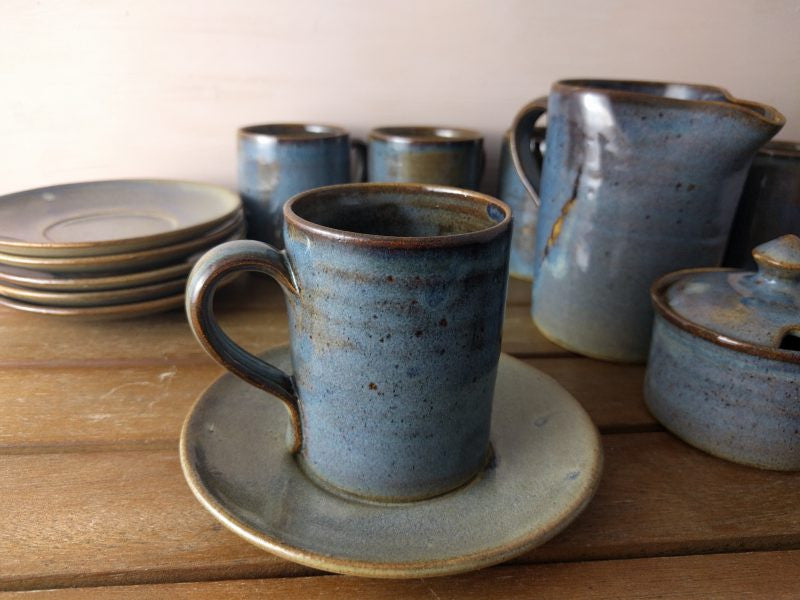
Clay Weights & Sizes For Handmade Tableware – Repeat Throwing Pottery
Share
I’ve spent the last few years trying to design and make the ultimate handmade tableware collection. The thing that has improved my pottery the most is using a gauge and repeat throwing the same clay weights.
Why make standard sized pottery with repeat throwing?
Some potters prefer to make tableware completely free form. Depending on their ability, they make be able to throw very similar pots each time, or they might enjoy variations in their work.

For me, I make one-off pieces to whatever size the clay allows. However, for tableware sets I’ve found it best to set a standard with repeat throwing. When I use a set of bowls or plates I want them to stack in an orderly fashion. I don’t mind a bit of irregularity, but they need to be stable when stacked. A pile of bowls falling off the shelf at breakfast would really ruin my morning.
I also feel that if someone buys a bowl or plate from me, they should be able to buy another one at a later date that is the same size. I once heard a potter say they want their pieces to look handmade but wellmade, which is what I aim for.
Perfect Sizes for Handmade Tableware
Arriving at the perfect size bowl, mug or plate takes some experimenting. The very first mugs I made turned out like something for Bilbo Baggins. I had neglected to consider shrinkage.
What the ‘perfect’ size is depends on personal preference of course, but the final size should be the starting point. I will often find my favourite mug, bowl or plant pot as a starting point. I will record the height and rim diameter in mm, then multiply by 1.13 as my total clay shrinkage after firing is 13%. At this point I convert the mm dimensions to the nearest 1/4″ values to give my throwing dimensions. I prefer to work to inches when throwing, it’s just easier to see clearly and quickly a 1/4″ mark than squinting at mm values.
I will then estimate the weight of clay needed to start with. Using the chart below could be a good help if you have not made a certain pot before. Usually they first try will be way off, and it’s important to get the right weight of clay to fit the pot dimensions. Too much clay and the pot will be heavy and cumbersome. Too little and the pot may collapse during throwing, or may be fragile once completed. After a few trys a good weight can be achieved and the gauge can be set for subsequent pots.
How to use a gauge when making handmade tableware
There are some speially made gauges for working in pottery, they may work very well but they cost money and I am tight. When I use a gauge it is just a lump of clay stuck to the side of my splash pan with a wooden BBQ skewer pressed into it. Once my ideal clay weight has been thrown to the required height and diameter, the end of the skewer is set just outside the rim. After the first pot is cut and lifted from the wheel, the others can be made to the exact same dimensions without remeasuring. A fairly hard lump of clay is prefered to avoid any movement in the skewer.
Examples of clay weights and sizes for tableware and other pottery
Over the years I have adjusted my sizes, and kept a very disorganised series of notes. I decided it was time to collect them all together and put them on a spread sheet. After doing that I thought it may prove useful or interesting for others and would post it here.
I have recently written about my new range of handmade tableware that will be available to buy soon. Many of the sizes in this chart will be used to create those items.
| A | B | C | D | E | |
|---|---|---|---|---|---|
|
1
|
Pot Name | Pot Weight(g) | Height (“) |
Rim Diam (“)
|
Notes |
|
2
|
small dip pot | 100 | 1 ½ | 3 | |
|
3
|
medium dip | 175 | 2 | 3¾ | |
|
4
|
small vase | 400 | 5 | ||
|
5
|
tea caddy | 600 | 3½ | ||
|
6
|
tea caddy lid | 300 | 3½ | ||
|
7
|
spoon rest | 150 | 1 | 4 | |
|
8
|
GP bowl | 460 | 3 | 6 | rolled rim |
|
9
|
salt pig | 350 | 4 | 4 | |
|
10
|
dinner plate | 2000 | 1½ | 12 | 1″ rim width, ½” deep base. 8½” flat centre. Trim footring |
|
11
|
side plate | 1000 | 1¼ | 9 | ½” thick base, 6″ flat centre, 5½” footring. Trim footring |
|
12
|
pasta bowl | 850 | 1¾ | 9 | throw 6½” x 3″ cylinder before pulling out. Trim footring |
|
13
|
bellied mug | 375 | 4¼ | 3¾ | |
|
14
|
tumbler | 400 | 5 | 3 | |
|
15
|
small plant pot | 700 | 5 | 5” inside diameter | |
|
16
|
yarn bowl | 1300 | 5 | 7 | 6″ base diameter |
|
17
|
olive oil bottle | 800 | 15/16″ inside neck diameter | ||
|
18
|
small GP bowl | 350 | 2½ | 5 | |
|
19
|
egg cup | 75 | 2″ inside Diameter | ||
|
20
|
olive dish | 325 | 1¼ | 5¼ | handle 2½” long ½” Diam sausage |
|
21
|
rough mugs | 375 | 4¼ | 3¾ | 3″ base diameter |
|
22
|
espresso cup | 150 | 2½ | 2¾ | 1¾” base diameter, curved profile |
|
23
|
6oz coffee cup | 280 | 3½ | 3½ | 2¼” base diameter |
|
24
|
8oz coffee cup | 325? | 3¾ | 4 | 2¾” base diameter |
|
25
|
6oz/8oz saucer | 350 | 1 | 5¾ | 1cm deep base |
|
26
|
espresso saucer | ||||
|
27
|
utensil holder | 1750 | 9 | 4 | straight sided |
|
28
|
bellied litre jug | 1250 | |||
|
29
|
bellied pint jug | 600 | |||
|
30
|
sugar pot | 250 | 3½ | need to make about 1 inch taller next time | |
|
31
|
sugar pot lid | 100 | |||
|
32
|
handleless milk jug
|
400 | need to make slightly smaller |

2 comments
Very helpful
Thanks for starting point for clay weights